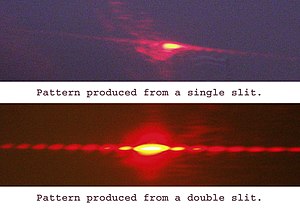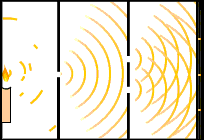Young's double-slit experiment

The double-slit experiment in quantum mechanics is an experiment, which was first performed by physicist Thomas Young in 1801. It shows that light has both a wave nature or characteristic and a particle nature or characteristic, and that these natures are inseparable. So, light is said to have wave–particle duality rather than be only a wave or only a particle. The same is true for electrons and other quantum particles.
The experiment[change | change source]

The base version of this experiment is very simple. It requires only a double slit device like the one in the picture, something to hold the double slit device still, and a good laser such as the kind that is used by workmen to "draw" straight lines when they are building. The laser is supported so it can only be moved on purpose. It is aimed at the central point between the two slits from a point about one half meter away. Something like a movie screen or a smooth white wall is put up on the other side of the double slit device several meters away. When everything is fixed, a pattern of light and dark bands will show up.

Lasers can produce one or more photons when given a certain amount of electricity. The photon or photons come out of a very small hole within a well known period of time. The speed of light is known, so the time the photons appear on the screen can be predicted. When photons are produced one at a time, what shows up on the screen are individual spots of light. If photons were waves then we would expect them to spread out as they travel and wash across a wide area of the screen, but that never happens. If photons were particles then we would expect them to appear at two points on the screen connected to the laser through the two slits in the middle. But that is not what happens either.
When Thomas Young did this experiment, he had no laser. He understood it by imagining light to be like waves of water. He thought that light waves moved out from the light source like waves spreading out from a pebble dropped into a pond, and that when the wave fronts hit the double slits, then the original wave gets through at the two slits and there are two different waves from then on. It was easy to figure out how two waves would interact to produce the bright bands and dark bands (often called "fringes") on the screen. He said he had proven the theory that light is waves.
But there were big problems. Light did not show up at the screen as waves that washed across it. Light came to be understood as swarms of photons that individually hit the detection screen. And, very surprisingly, a single photon could interfere with itself as though it were a single wave that fit the old wave description. It split into two waves at the double-slit device, and they then combined at the screen.
Importance to physics[change | change source]
The double-slit experiment became a classic thought experiment for its clear explanation of the central puzzles of quantum mechanics.
Importance to philosophy[change | change source]
The double-slit experiment has been of great interest to philosophers, because the quantum mechanical behavior it shows has forced them to rethink their ideas about classical concepts such as:
Experience in the micro world of sub-atomic particles forces us to re-conceptualise some of our most ordinary ideas. [why?]

Other websites[change | change source]
- Quantum Physics explains the double slit experiment (cartoon from the movie "What the Bleep do we know?)[permanent dead link]
- Movie of double-slit experiment done with electrons. You can see single electrons hit the screen, and you can see the fringes build up over time.
References[change | change source]
- ↑ Philipp Frank, Philosophy of Science, p. 200f.
